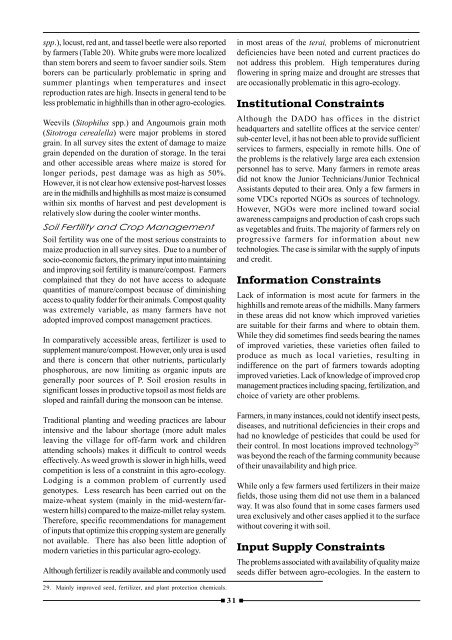Create successful ePaper yourself
Turn your PDF publications into a flip-book with our unique Google optimized e-Paper software.
spp.), locust, red ant, and tassel beetle were also reportedby farmers (Table 20). White grubs were more localizedthan stem borers and seem to favoer sandier soils. Stemborers can be particularly problematic in spring andsummer plantings when temperatures and insectreproduction rates are high. Insects in general tend to beless problematic in highhills than in other agro-ecologies.Weevils (Sitophilus spp.) and Angoumois grain moth(Sitotroga cerealella) were major problems in storedgrain. In all survey sites the extent of damage to maizegrain depended on the duration of storage. In the teraiand other accessible areas where maize is stored forlonger periods, pest damage was as high as 50%.However, it is not clear how extensive post-harvest lossesare in the midhills and highhills as most maize is consumedwithin six months of harvest and pest development isrelatively slow during the cooler winter months.Soil Fertility and Crop ManagementSoil fertility was one of the most serious constraints tomaize production in all survey sites. Due to a number ofsocio-economic factors, the primary input into maintainingand improving soil fertility is manure/compost. Farmerscomplained that they do not have access to adequatequantities of manure/compost because of diminishingaccess to quality fodder for their animals. Compost qualitywas extremely variable, as many farmers have notadopted improved compost management practices.In comparatively accessible areas, fertilizer is used tosupplement manure/compost. However, only urea is usedand there is concern that other nutrients, particularlyphosphorous, are now limiting as organic inputs aregenerally poor sources of P. Soil erosion results insignificant losses in productive topsoil as most fields aresloped and rainfall during the monsoon can be intense.Traditional planting and weeding practices are labourintensive and the labour shortage (more adult malesleaving the village for off-farm work and childrenattending schools) makes it difficult to control weedseffectively. As weed growth is slower in high hills, weedcompetition is less of a constraint in this agro-ecology.Lodging is a common problem of currently usedgenotypes. Less research has been carried out on themaize-wheat system (mainly in the mid-western/farwesternhills) compared to the maize-millet relay system.Therefore, specific recommendations for managementof inputs that optimize this cropping system are generallynot available. There has also been little adoption ofmodern varieties in this particular agro-ecology.Although fertilizer is readily available and commonly usedin most areas of the terai, problems of micronutrientdeficiencies have been noted and current practices donot address this problem. High temperatures duringflowering in spring maize and drought are stresses thatare occasionally problematic in this agro-ecology.Institutional ConstraintsAlthough the DADO has offices in the districtheadquarters and satellite offices at the service center/sub-center level, it has not been able to provide sufficientservices to farmers, especially in remote hills. One ofthe problems is the relatively large area each extensionpersonnel has to serve. Many farmers in remote areasdid not know the Junior Technicians/Junior TechnicalAssistants deputed to their area. Only a few farmers insome VDCs reported NGOs as sources of technology.However, NGOs were more inclined toward socialawareness campaigns and production of cash crops suchas vegetables and fruits. The majority of farmers rely onprogressive farmers for information about newtechnologies. The case is similar with the supply of inputsand credit.Information ConstraintsLack of information is most acute for farmers in thehighhills and remote areas of the midhills. Many farmersin these areas did not know which improved varietiesare suitable for their farms and where to obtain them.While they did sometimes find seeds bearing the namesof improved varieties, these varieties often failed toproduce as much as local varieties, resulting inindifference on the part of farmers towards adoptingimproved varieties. Lack of knowledge of improved cropmanagement practices including spacing, fertilization, andchoice of variety are other problems.Farmers, in many instances, could not identify insect pests,diseases, and nutritional deficiencies in their crops andhad no knowledge of pesticides that could be used fortheir control. In most locations improved technology 29was beyond the reach of the farming community becauseof their unavailability and high price.While only a few farmers used fertilizers in their maizefields, those using them did not use them in a balancedway. It was also found that in some cases farmers usedurea exclusively and other cases applied it to the surfacewithout covering it with soil.Input Supply ConstraintsThe problems associated with availability of quality maizeseeds differ between agro-ecologies. In the eastern to29. Mainly improved seed, fertilizer, and plant protection chemicals.31
















